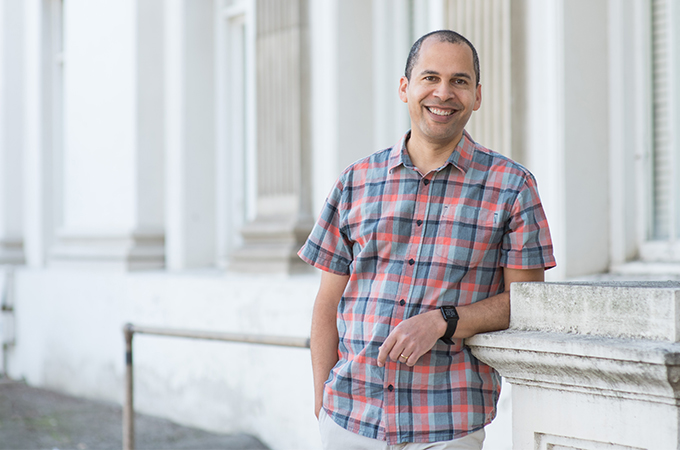What does it mean to be black and alive? That was a question Andre Myers, a professor of composition in the University of Redlands School of Music, was grappling with this summer. As he worked on a chamber orchestra piece for an Albany Symphony Orchestra commission, he spent hours reflecting on the national unrest sparked by the killings of George Floyd, Breonna Taylor, and others.
The result is “Black and Alive,” a musical composition inspired by the cooperative action of those who took to the streets. “Writing this piece, I was reflecting on that most American of institutions—protest,” he says. “I was thinking about how patriotic it is to get out into the streets, peacefully march, and make your voice heard.”
In the 15-minute piece, blackness serves as an inspiration, and a springboard for thriving and living, upending cultural narratives wherein blackness is associated with death. Myers says, “I wanted to flip that narrative.”
The work begins quietly, with peaceful meditation and affirmation using string, brass, and wind instruments. It advances to a determined march, with a polyphonic sound keeping time to a drumbeat, and ends on notes of triumph and hope. “It’s a recognition that different types of voices are coming together to say no American should suffer from intimidation in this country because of their race,” Myers explains. “And that we are going to get through this [difficult time] by working towards justice.”
Using life experiences
Myers, who began playing piano at 10 and was composing and teaching music as a teenager, is no stranger to using his life experiences to inform his music. After graduating from the Eastman School of Music with a degree in composition, he had a brief stint as a hip-hop artist: “I made my turn to hip-hop because I wanted to explore all aspects of my cultural identity as an African American in ways I couldn’t do as a classical artist.”
Later, when earning his doctorate in composition at the University of Michigan, Myers realized that his time producing hip-hop helped him write his dissertation: an orchestra piece for narration and orchestra entitled “Paddle to the Sea.”
“There isn’t a part of me that I want to leave out of the process of writing music,” he says. “That’s why I was pleased to process issues of race and existentialism in ‘Black and Alive’ in ways I had not been able to tackle before.” Myers says his understanding and love for African American musical forms (“of which hip-hop is a really important one”) has informed his practice not just as a composer but as a teacher.
A Redlands resident since 2012, Myers hopes to one day see his work performed close to home. “It is a piece of its time, but my hope is that it is a piece—like all classical music—that’s able to extend beyond its time.”
“Black and Alive” is Myers’ second commission for the Albany Symphony Orchestra. The first, “Studies in Hope: Frederick Douglass,” celebrated the work and life of abolitionist Frederick Douglass and was performed in 2019 by an ensemble that featured MCs, a high school choir, and an orchestra.
‘Hunger to connect’
Myers joined the U of R School of Music full time in 2020, and, despite having to start at a new institution during a pandemic and adjusting to teaching virtually, he says he’s honored to be here. “The resilience, strength, and courage of the students, faculty, and staff at Redlands have been impressive,” he says.
As a composition professor, there haven’t been drastic changes to his teaching methods during COVID-19 (“most of the work is one on one”). Myers can still help his composition students find the processes, motivation, and understanding to help them reach their best musical vision. “My students have a great hunger to connect with others—intellectually and artistically—through music, so always I look for opportunities to celebrate that connection.”
Myers’ ethos also fits well with U of R’s commitment to developing students as global citizens through personalized education. “This generation of composers and musicians will lead the conversation on how music is understood in the 21st century, so their education must be grounded in compassion,” he says. “Musical harmony is the combination of dissonance and consonance; if we recognize that as musicians, we’ll be able to bring that into our lives as citizens of the world.”
“Black and Alive” debuted in a live-streamed ASO performance made exclusive to subscribers on Nov. 14, but audiences can view the virtual concert beginning Nov. 20 with a $25 donation. For more information, go to albanysymphony.com.






